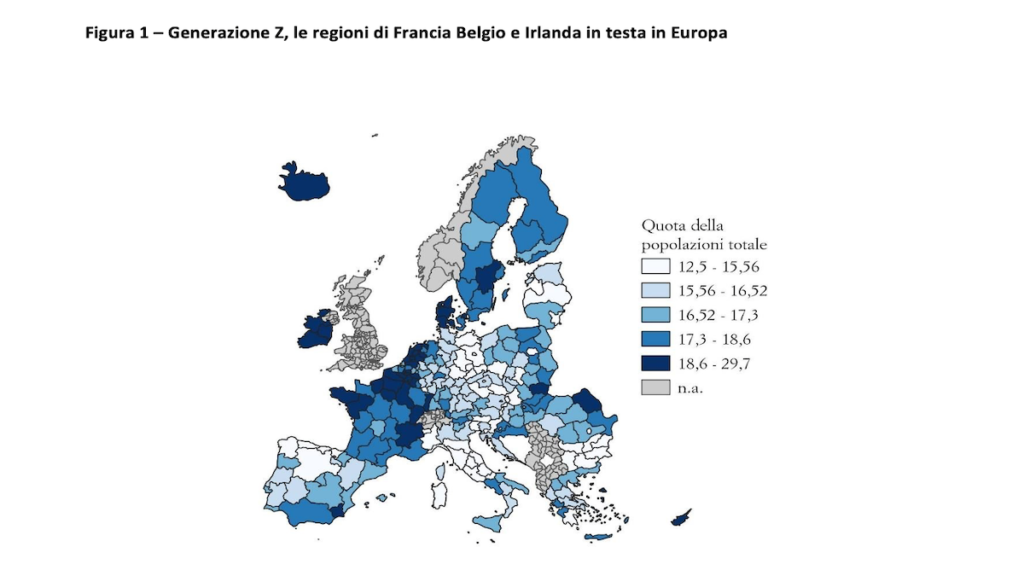The demographic decline anticipates the economic one: the decline in youth andincrease in the elderly they reduce a population's learning ability and creativity and openness to new things. This is what the new analysis of the North East Foundation. In Europe, the Italian regions are those where there are fewer children and young people and the denser group of over-800s. Furthermore, if up to the mid-XNUMXs the life expectancy of an adult was 60 years old, and adults became 15 years old, or a little more. Today, however, already at birth you can aim for 80 years. Actually more, because life lengthens as it unfolds, thanks to medical advances and in physical and mental well-being. This means that newborns and others close to becoming over one hundred years old coexist on the planet today, and often in the same family. That is four generations: never happened before in history.
But distance isn't just measured in years. Between a Founder or Mature it's a Alpha Gen the gap is analogous to that between a medieval farmer and a skilled car worker sixty years ago. Anyone who has gone through the Second World War or who has witnessed the first human walk on the Moon is displaced by the digital speed of children, who today leaf through a book page thinking it is touch.
Only companies and businesses that manage to do dialogue between different generations, overcoming the Babel of languages and cultural approaches to life and work, improve productivity, income and well-being.
Why deal with generations and demographics, the scenario:
- In Italy the average age is 46,2 years.
– In 2021, 398 children were born, the lowest number ever.
– To support the stability of social systems the fertility index should be 2,1 children per woman of childbearing age, today in Italy it is equal to 1,25.
– Italy is the European country with the lower number of young people and children.
- The share of NEETs Italians is the highest in Europe.
– The average age of workers in the Italian public administration is 55, while 60% of employees work in the private sector with an average age of 46.
– Out of 4,5 million employed Baby Boomers by 2025, 1 million will retire; therefore, retirees will go from 16 to 17 million, against 23 million employed people.
– In Italy the workers are the oldest in Europe.
– The over 55s are the first generation in Italy to have recorded an extension of their professional life by at least 10-15 years.
– Millennials and X Generations (28-55 years old) are asking for remote work, purpose and meaning of their activities, recognition of merit, greater flexibility of working hours and places and autonomy in achieving objectives.
For the first time 7 (SEVEN!) generations coexist on Earth
For the first time in human history seven different generations coexist on the Earth. A fact produced by the lengthening of life. Doesn't it add up? In fact: normally one generation is counted every 25 years; ergo, considering the centenarians, at most the cohabiting generations are four. But, as underlined by Isabella Pierantoni in the 2022 Report of the North East Foundation, the future is passing. Who is ready and who is not, when it comes to generations we cannot limit ourselves to considering age but above all we need to consider the way of thinking and looking at the world, which is shared by people who were born in the same period.
The starting idea of this different way of defining generations is that, using Pierantoni's words, «the historical-social, economic or political events that children see happening as they grow up – between 78 years and 13-14 – help form theirs World vision, to build a sense of security and trust, together with the idea of a future that will be worth living and fighting for». According to evolutionary psychologists, it is precisely in those years that children begin to imagine the future; in other words, they begin to wonder if and how much the events they observe outside the family context will affect them safety e future stability.
Which and how many generations?
When thinking about generations it is easy to fall into the trap of "labels". But this one is worth running risk if this can help us learn to recognize when and how the different act attitudes generational. Because, precisely, people who were born in the same period share the same orientations of thought. Here then is the taxonomy of the seven generations currently present on Earth, even taking into account that the boundaries are not as clear-cut as the birth interval suggests:
- Alpha Gen (2011-2025) age 2022: 0-11 years
- Z Gen (1995-2010) age 2022: 12-27 years
- Y-Millennials (1994-1980) age 2022: 28-42 years
- XGeneration (1965-1979) age 2022: 43-57 years
- BB - Baby Boomer (1946-1964) age 2022: 58-76 years
- Mature (1925-1945) age 2022: 77-97 years
- Founders (<= 1924) age 2022: greater than or equal to 98 years
The distribution of the population between different generations affects the development of a territory
Territories process the memory of the past, live the present and imagine the future with the minds of their inhabitants. And the coexistence of several generations changes the cognitive and creative processes. Especially since among the elements that most differentiate the generations there are the vision of the future, the approach to technology e access to tools (digital) that have contributed to changing the idea of work and competence. All relevant elements in the digital transition phase that our society is facing.
Let's try to make some examples: growing up in the 70s (the Generazione X) meant hearing about, for example, unemployment, the energy crisis, the spread of drug use. A context that encourages us to acquire a sense of caution and control over the world, people and institutions and probably to consider security as an essential and non-negotiable value. Attitudes that guide, for example, the propensity and investment choices.
The previous generation, that of the Baby boomer, witnessed the arrival of man on the moon and may have developed a sense of optimism towards a better future (made possible by the availability of resources) and great trust in institutions.
I Millennials they had native access to a number of technologies that changed their relationship with work. People who belong to this generation they change jobs every three or four years, if they are not adequately motivated and if their expectations are frustrated. Again, Millennials and members of the X Generation are the ones who ask most frequently for work remotely, to have one greater flexibility of time and place of work and also autonomy in achieving objectives. In recent years there has been more and more talk of YOLO economy, to define the way of living and thinking about work of the younger generations. YOLO stands for "You Only Live Once", you only live once, referring to the choice to avoid or abandon life and work commitments felt as unsatisfactory and burdensome, a completely different attitude from that of the Baby Boomers.
The distribution of different generations among the European regions it is not homogeneous. The regions that have the highest percentage of people belonging to generation Z are located in France, Belgium, Ireland e Denmark. Millennials dominate the Eastern European regions, while Generation X characterizes the regions Italy and Spain.
The different compositions of the populations impact on the economies of the European regions by diversions: the more intuitive ones refer to the fact that the regions with a population more skewed towards Baby Boomers and Matures will find themselves facing problems related to the thinning of the workforce, which in the short and medium term can only find an answer in policies aimed at attracting workers from other regions. Again, strategies to deal with the increase in diseases related to ageingwhich will inevitably lead to an increase in health expenditure. It must also be said that the improvement in the quality of life in old age will lead to new needs to be satisfied, modifying the structure of consumption, thus generating new opportunities. But there is a further, perhaps less intuitive, implication linked to population structure: young people are growing up in an age characterized by great uncertainty and this forces them to develop new ways of adapting to rapidly changing situations. Modes that could be useful for everyone. The risk for the "older regions" is that they are slower not only to build futures but also to change quickly from one scenario to another.
The Italian regions, which have few Generation Z inhabitants, few Millennials and a lot of Generation X, risk being less adaptive and unable to reap the benefits of technological changes.
Five generations working together: the problems for companies
Attract new generations
Digital skills generate a competitive advantage for younger generations in the labor market who are better equipped than non-digital native generations. To face the transition to digital, companies need adequate skills and therefore to be able to attract young people, especially those who belong to the Millennial generation and Generation Z. In attracting them, the mistake not to be made is to ignore the idea of work that these generations have. It has already been said, for example, that Millennials are more frequently asking to work remotely, to have greater flexibility of working hours and places but also autonomy in achieving their goals. Members of this generation are also led to frequently change jobs. How do you manage all this from an organizational point of view? For turnover it is necessary to provide for faster rotation phases (almost plug and play), which means coding work processes as much as possible and favoring the sedimentation of knowledge at company level.



To bring together five generations of workers
Considering the lengthening of working lives, it is possible that within the same organization people of five different generations on a cognitive level find themselves working. What implications does such a coexistence have? If we think about the organization of work, the coexistence of people of different ages and skills could generate conflicts, for example due to the fact that older workers could fear being "put aside" when younger workers join. As pointed out by Paul Gubitta, of the University of Padua, this situation can fuel the difficulty for mature workers to accept much younger hierarchical superiors. This could lead to a loss of competitiveness for organizations that are unable to bring together people of different ages and, above all, distant in knowledge and visions of the world. Diversity and distance, on the other hand, can be used as a source of mutual enrichment and nurture corporate skills and creativity.
°°°°°°°°° The author is a senior researcher at the Fondazione Nord Est





